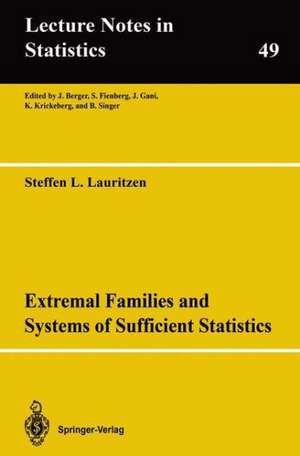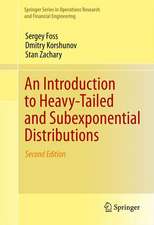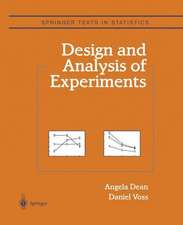Extremal Families and Systems of Sufficient Statistics: Lecture Notes in Statistics, cartea 49
Autor Steffen L. Lauritzenen Limba Engleză Paperback – 28 noi 1988
Din seria Lecture Notes in Statistics
- 15%
 Preț: 631.86 lei
Preț: 631.86 lei -
 Preț: 385.84 lei
Preț: 385.84 lei - 17%
 Preț: 490.19 lei
Preț: 490.19 lei - 17%
 Preț: 460.28 lei
Preț: 460.28 lei - 18%
 Preț: 945.92 lei
Preț: 945.92 lei - 20%
 Preț: 561.42 lei
Preț: 561.42 lei - 18%
 Preț: 943.25 lei
Preț: 943.25 lei - 18%
 Preț: 943.25 lei
Preț: 943.25 lei - 18%
 Preț: 995.97 lei
Preț: 995.97 lei - 15%
 Preț: 641.38 lei
Preț: 641.38 lei -
 Preț: 436.14 lei
Preț: 436.14 lei - 15%
 Preț: 633.53 lei
Preț: 633.53 lei - 15%
 Preț: 658.88 lei
Preț: 658.88 lei -
 Preț: 383.33 lei
Preț: 383.33 lei - 15%
 Preț: 640.71 lei
Preț: 640.71 lei - 18%
 Preț: 947.18 lei
Preț: 947.18 lei - 18%
 Preț: 1007.35 lei
Preț: 1007.35 lei - 18%
 Preț: 942.63 lei
Preț: 942.63 lei - 15%
 Preț: 639.59 lei
Preț: 639.59 lei - 18%
 Preț: 1231.47 lei
Preț: 1231.47 lei - 15%
 Preț: 643.00 lei
Preț: 643.00 lei - 18%
 Preț: 886.62 lei
Preț: 886.62 lei -
 Preț: 383.12 lei
Preț: 383.12 lei - 15%
 Preț: 633.35 lei
Preț: 633.35 lei - 15%
 Preț: 635.65 lei
Preț: 635.65 lei -
 Preț: 393.74 lei
Preț: 393.74 lei - 15%
 Preț: 632.70 lei
Preț: 632.70 lei - 15%
 Preț: 637.28 lei
Preț: 637.28 lei - 15%
 Preț: 702.87 lei
Preț: 702.87 lei - 15%
 Preț: 642.68 lei
Preț: 642.68 lei - 15%
 Preț: 644.63 lei
Preț: 644.63 lei - 15%
 Preț: 645.14 lei
Preț: 645.14 lei -
 Preț: 382.36 lei
Preț: 382.36 lei - 15%
 Preț: 636.30 lei
Preț: 636.30 lei - 15%
 Preț: 647.92 lei
Preț: 647.92 lei -
 Preț: 380.63 lei
Preț: 380.63 lei - 18%
 Preț: 887.05 lei
Preț: 887.05 lei - 15%
 Preț: 634.32 lei
Preț: 634.32 lei - 15%
 Preț: 648.74 lei
Preț: 648.74 lei -
 Preț: 378.92 lei
Preț: 378.92 lei - 15%
 Preț: 648.56 lei
Preț: 648.56 lei - 15%
 Preț: 647.59 lei
Preț: 647.59 lei - 18%
 Preț: 780.37 lei
Preț: 780.37 lei - 15%
 Preț: 641.20 lei
Preț: 641.20 lei - 18%
 Preț: 1102.69 lei
Preț: 1102.69 lei - 15%
 Preț: 643.16 lei
Preț: 643.16 lei -
 Preț: 384.70 lei
Preț: 384.70 lei
Preț: 775.44 lei
Preț vechi: 945.65 lei
-18% Nou
Puncte Express: 1163
Preț estimativ în valută:
148.39€ • 154.05$ • 123.74£
148.39€ • 154.05$ • 123.74£
Carte tipărită la comandă
Livrare economică 24 martie-07 aprilie
Preluare comenzi: 021 569.72.76
Specificații
ISBN-13: 9780387968728
ISBN-10: 0387968725
Pagini: 268
Ilustrații: XV, 268 p.
Dimensiuni: 155 x 235 x 15 mm
Greutate: 0.41 kg
Ediția:1988
Editura: Springer
Colecția Springer
Seria Lecture Notes in Statistics
Locul publicării:New York, NY, United States
ISBN-10: 0387968725
Pagini: 268
Ilustrații: XV, 268 p.
Dimensiuni: 155 x 235 x 15 mm
Greutate: 0.41 kg
Ediția:1988
Editura: Springer
Colecția Springer
Seria Lecture Notes in Statistics
Locul publicării:New York, NY, United States
Public țintă
ResearchCuprins
I The Case of a Single Experiment and Finite Sample Space.- 1. Basic facts. Maximal and extremal families.- 2. Induced maximal and extremal families.- 3. Convexity, maximal and extremal families.- 4. Some examples.- II Simple Repetitive Structures of Product Type. Discrete Sample Spaces.- 0. Conditional independence.- 1. Preliminaries. Notation.- 2. Notions of sufficiency.- 3. Maximal and extremal families.- 4. Limit theorems for maximal and extremal families.- 5. The topology of$$\left( {\mathop{{\dot{U}}}\limits_{n} {{y}_{n}}} \right)UM.$$Boltzmann laws.- 6. Integral representation of M.- 7. Construction of maximal and extremal families.- 8. On the triviality of the tail ?-algebra of a Markov chain.- 9. Examples of extremal families.- 10. Bibliographical notes.- III Repetitive Structures of Power Type. Discrete Sample Spaces.- 0. Basic facts about Abelian semigroups.- 1. Extremal families for semigroup statistics.- 2. General exponential families.- 3. The classical case.zd-valuedstatistics.- 4. Maximum likelihood estimation in general exponential families.- 5. Examples of general exponential families.- 6. Bibliographical notes.- IV General Repetitive Structures of Polish Spaces. Projective Statistical Fields.- 0. Probability measures on Polish spaces.- 1. Projective systems of Polish spaces and Markov kernels.- 2. Projective statistical fields.- 3. Canonical projective statistical fields on repetitive structures.- 4. Limit theorems for maximal and extremal families on repetitive structures.- 5. Poisson Models.- 6. Exponential Families.- 7. Examples from continuous time stochastic processes.- 8. Linear normal models.- 9. The Rasch model for item analysis.- 10. Bibliographical notes.- Literature.















